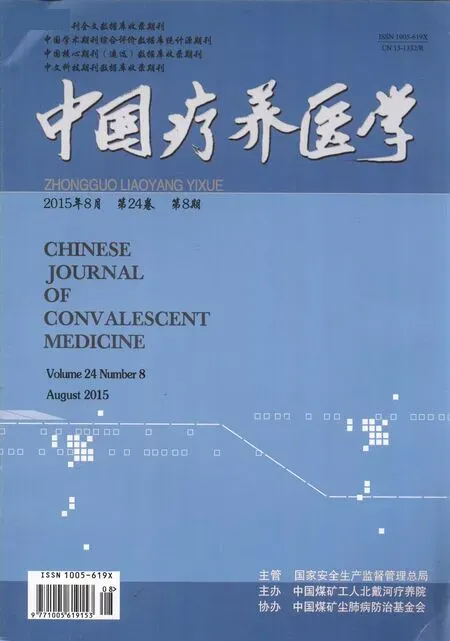环境因素对呼出气一氧化氮的影响
林汉军
环境因素对呼出气一氧化氮的影响
林汉军
呼出气一氧化氮(FeNO)被认为是检测哮喘和呼吸道变态反应引发的气道炎症的一种非侵袭性生物标记物环境因素,特别是室内和室外空气质量可能在诱发呼吸道症状急性加重中扮演了重要的角色。城市和工业污染,主要是颗粒物(PM2.5和PM10),二氧化氮(NO2),二氧化硫(SO2),甲醛(formaldehyde)会引起FeNO升高。虽然还需要更多的相关研究来进一步确定FeNO用来管理哮喘的价值,临床医生推荐应考虑环境因素对哮喘和呼吸道变态反应患者的影响。进一步的研究应该波及在治疗时减少环境暴露因素对这些疾病的影响。
呼出气一氧化氮;环境因素;哮喘
1 引言
在过去的几十年中,哮喘和变态反应性疾病的发病率有所增加,这种情况在经济发达国家的城市儿童中尤其明显。这就让人们猜测是否环境因素,尤其是室内和室外空气质量,在诱发哮喘和变态反应中扮演了重要的角色。儿童尤其容易受到环境因素的伤害,因为和成人相比,儿童每千克体质量吸入了更高容积的气体,他们的肺还在发育,免疫系统还不完善,机体的防御机制还在进化。如果肺的防御机制被破坏,肺的发育和内环境稳定就会被干扰,可以断定,对肺发育的破坏和急性损害会导致慢性肺功能的损害。肺发育损害会减少成年期可能达到的最大肺容积及肺功能储备,增加对年龄、感染和污染的易感性[1]。呼出气一氧化氮(fractional concentration of exhaled nitric oxide,FeNO)被认为是哮喘和呼吸道变态反应管理的一种非侵袭性生物标记物[1]。FeNO检测易于操作且患者容易接受,尤其方便儿童检查[2]。另外,相对于诱导痰嗜酸粒细胞计数等其他检查,FeNO检测更简单、更快速[3]。因为这个原因,有的作者把FeNO检测作为肺功能检查的补充,以便更好地控制哮喘症状或病情恶化。
气道内源性NO由精氨酸在NO合成酶的作用下产生,它们有两种构型,其中一种可诱导的亚型与呼吸道炎症相关,它们的表达由炎性细胞因子激发。FeNO水平与诱导痰及支气管肺泡灌洗液中嗜酸粒细胞计数以及气道嗜酸粒细胞浸润有关,其中过敏体质者尤其明显[4]。有充分的证据显示哮喘在治疗之前FeNO升高,而在激素治疗之后,FeNO降低[5]。另外,FeNO水平升高提示潜在的呼吸道炎症,即使在没有症状和没有肺功能损害的时候。因此,FeNO可作为说明抗炎治疗在呼吸道变态反应治疗中的合理性的一个有代表性的工具。但是,目前还缺少有关这方面检测对疾病治疗决策的长期益处的数据。Gagliardo等人发现,在为期一年的随访观察中,中度哮喘患者FeNO水平升高与病情恶化相关[6],但Cabral等人却发现并非如此[5]。这些研究的不一致性有待更多的相关研究来进一步确定。
2 室外污染和FeNO
由于气道炎症是哮喘的特征之一,FeNO也许能用来评估空气污染对哮喘患者气道炎症状态的影响。实际上,我们知道空气污染与老年哮喘患者、健康成年人[7]以及学龄儿童[8]的FeNO相关。有充分的证据显示室外空气污染对城市儿童的呼吸道健康有害[9]。一般来讲,哮喘儿童对臭氧(O3),微小颗粒(PM10,PM2.5),二氧化氮(NO2),二氧化硫(SO2)等室外空气污染物尤其敏感。虽然污染物暴露对气道炎症的影响机制还不完全清楚,但是我们知道空气污染扮演了主要角色。基于这种认识,由活性氧诱导的氧化应激可能激活某些转录因子,继之引起炎性细胞因子分泌及炎性细胞募集。最终通过可诱导的一氧化氮合成酶(iNOS)诱导上皮细胞产生NO[10]。而且有实验证据显示微小颗粒(PM)中的有机成分对气道炎症起辅助作用,其中一部分通过暴露于具有氧化还原活性的化学物质以及氧化应激反应起作用[11]。PM中的有机成分还会降低患有COPD的老年患者以及患有哮喘的儿童的肺功能[12]。
Rusconi等人通过对比居住在萨丁尼亚石化产品污染区和居住在对照区的有哮喘及喘息症状的儿童及青少年与健康儿童及青少年的肺功能、气道炎性标志和氧化应激反应,他们发现,居住在污染区的儿童的肺功能FEV1和FEF25-75下降,FeNO水平升高,同时这个地区的某些污染,尤其是PM10和SO2升高[13]。最近,Renzetti等人发现,把那些居住在高污染城市环境的哮喘儿童放在农村后,FeNO浓度明显下降[1]。
Flamant-Hulin等人得出了相同的结论,他们发现暴露于高浓度的甲醛、乙醛和PM2.5的哮喘和非哮喘儿童的FeNO水平明显上升。那些有过敏症的非哮喘儿童与之有更紧密的联系,提示他们比无过敏症的儿童对空气污染更加敏感[14]。换句话说,哮喘和过敏就像是FeNO水平升高的辅助因子。FeNO水平与变态反应的关系,也许能帮助理清敏感性在决定转化成临床过敏症的各种复杂的相互作用的多因子中的相关角色。
3 室内污染物与FeNO
自从人们普遍把大多数时间都花在室内,越来越多的科学证据显示室内污染在影响健康中扮演了重要角色。室内环境通过与室外污染复杂的相互关系对污染暴露人员产生重要影响[15]。我们知道室内空气污染物会引起哮喘患者变态反应和气道炎症[16]。成人和儿童对室内变应原的敏感性与FeNO升高相关[17]。Sofia等人建议可以把FeNO作为评估室内污染物对气道不良影响的标志[18]。
对变应的敏感性可能在气道FeNO升高中扮演了重要的角色。在Cibella等人[19]领导的一项实验中,只有对螨虫和猫的毛屑敏感的被观察者才会出现FeNO水平升高。同样,Leuppi等人发现,过敏体质儿童的FeNO水平升高与对常年性的变应原敏感有关,而不是季节性的变应原[20]。Spanier等人[21]发现,对猫和狗的毛屑敏感与FeNO水平升高有关;Kovesi和Dales等人[22]却发现,养狗而不是养猫与FeNO水平改变有关。很多与住宅有关的因素与儿童气道炎症相关,据Kovesi和Dales报道,热风供暖室内的尘螨水平较低,而电力供暖可能引起室内尘螨水平升高,以及对变应的敏感性及FeNO水平升高。另外,他们还发现,电力供暖室内的甲醛浓度更高,这也引起了儿童的FeNO水平升高。Pasquale等人[23]通过对经常去游泳池的儿童(1~2 h/周)的观察,以气道嗜酸粒细胞性为炎症的标志物,验证了氯气暴露与FeNO水平FeNO升高相关的假说,发现经常去游泳池的儿童与不去游泳池的儿童的FeNO水平相近,说明间断暴露于氯气并不引起气道的嗜酸粒细胞性炎症。另外两个研究评估了另一种目前常见的室内污染物——聚氯乙烯暴露对FeNO水平的影响,Tuomainen等人发现,聚氯乙烯暴露对观察者的FeNO水平没有影响[24];而Kolarik等人的观察却相反,他们发现与对照组相比,暴露者的FeNO水平明显升高,提示塑料物质的暴露可能会引起亚临床的气道炎症[25]。
4 吸烟与FeNO
很多研究调查了吸烟对儿童和成人FeNO的影响,有一致的证据表明主动吸烟以及严重的烟草暴露会引起健康及哮喘成人的FeNO水平暂时下降[26-27]。就目前我们所了解的,还没有证据显示被动吸烟会对健康儿童的FeNO造成影响。而对哮喘儿童的研究结果是不一致的,分析原因可能是实验方法的问题(样本太小,实验人群不一样,缺少对实验干扰因素的控制等)。不同的研究并没有发现环境烟草暴露与哮喘儿童FeNO水平有明显关联。尤其是Laoudi等人发现,与未吸烟暴露的哮喘儿童相比,吸烟暴露的哮喘儿童FeNO水平更低一些[28]。这能解释不同类型的暴露所产生的不同机制。因为烟草中含有更高浓度的一氧化氮,急性烟草暴露刺激会引起诱生型一氧化氮合成酶(iNOS)产生负反馈,从而引起FeNO水平暂时下降。而对于持续暴露的机制还不清楚,可能的假设是持续的iNOS负反馈抑制了iNOS基因表达。
基因差异也许可以解释烟草暴露对FeNO水平影响的研究的不一致的结果。Spanier等人发现一种一氧化氮合成酶基因(NOS3)的多态性(外显子7突变)改变了尼古丁暴露对FeNO水平的影响,作者注意到这种基因的多态性决定了暴露于烟草的儿童的FeNO水平下降,可能是通过环境及基因的联合因素抑制了酶的活性[29]。
Salam等人[30]发现,一氧化氮合成途径基因的改变促成了儿童FeNO水平的改变。尤其是一氧化氮合成酶-2A(NOS2A)的单个核苷酸的多态性以及血清精氨酸-2(ARG2)的单个核苷酸的多态性与低FeNO水平有重要关系。他们同时还注意到血清精氨酸-2的单个核苷酸的多态性NOS2A对FeNO的影响。因此,FeNO水平依赖于NOS2A及ARG2的变化。这种基因间的相互影响可能归咎于对一种共同底物的竞争:L-精氨酸,因为L-精氨酸可以抑制iNOS的表达以减少NO的合成。有的研究也发现基因对儿童哮喘有很强的影响,因此,那些影响FeNO水平的基因改变是哮喘的重要因素。
5 环境污染物暴露的儿童FeNO测量的不一致性
很多参考文献认为FeNO是检测环境污染对儿童影响的补充性工具之一。然而在这些研究中有一些是不一致的,这些变化主要跟研究的人群有关(比如遗传变异、过敏体质和非过敏体质、哮喘和非哮喘患者等),包括治疗效果 (比如哮喘患者吸入皮质激素),以及不同的污染物暴露(比如个人环境和周围环境,暴露的水平,短期和长期等)。
先前的研究发现,过敏体质本身对FeNO水平有重要影响,即便是没有症状的个体也是如此。FeNO水平和皮肤试验阳性者间存在重要联系,最高水平的FeNO在内科医师诊断的变态反应的儿童中观察到。因此,哮喘和变态反应的联系似乎一致性地预示了高水平的FeNO。早先的研究显示FeNO水平在哮喘儿童中升高,而激素治疗后FeNO水平下降[31]。哮喘状态也许是空气污染与FeNO之间的效应调节因子。周围环境与个人环境的对比试验显示FeNO水平与个人的易感性或特定的污染物有关。Berhane等人强调,周围环境污染可能潜在增加健康和易感儿童氧化应激反应,研究中不同暴露水平试验的结果差异性增大[31]。实际上,在最终说明污染与FeNO水平的关联性时,这些多样性的污染模型将会得到改进。
总之,目前的证据显示不同的FeNO测量方法在环境暴露的儿童身上表现出了不一致性,进一步的研究应该确定FeNO能否作为一个有用的工具检测环境污染对呼吸道的不良影响。
6 结论
因为很多因素过敏、性别、季节、皮质激素吸入治疗都会影响FeNO水平。在研究其他影响因素之前,临床医生和研究者应了解哮喘患者的个体的FeNO基础水平。另外,临床医生也应该考虑到一些室内污染因素,比如室内过敏原[31],主要是螨虫和宠物,以及电热装置、室内高浓度甲醛、使用炭火炉、蜡烛或者煤气炉、氯气PVC暴露等。
由于环境干预是哮喘管理中的一项重要的措施,FeNO也许在把控制环境诱发因素整合进哮喘管理中有用。假设空气污染引起的气道炎症反应是可逆的,就可以期待限制空气污染能减少气道炎症。因此,对FeNO水平的评估可能帮助我们管理那些暴露于环境污染的哮喘患者。
回顾已有的证据,我们推荐进一步的研究应该是横向的多中心联合的流行病学调查,包括不同的国家,不同的种群以及各水平的环境污染,以便研究基因与环境的相互作用对FeNO水平的影响。这些研究设计应该有助于获得可靠的FeNO参考值。随后,成批病例对照研究应该评估治疗措施对FeNO水平的影响。这样的研究设计应该允许临床医生从公共健康的角度出发。
[1]Renzetti G,Silvestre G,D'Amario C,et al.Less air pollution leads to rapid reduction of airway inflammation and improved airway function in asthmatic children[J].Pediatrics,2009,123(3):1051-1058.
[2]Pijnenburg MWH,De Jongste JC.Exhaled nitric oxide in childhood asthma:a review[J].Clinical and Experimental Allergy,2008,38(2):246-259.
[3]Gagliardo R,La Grutta S,Chanez P,et al.Non-invasive markers of airway inflammation and remodeling in childhood asthma[J].Pediatric Allergy and Immunology,2009,20(8):780-790.
[4]Strunk RC,Szefler SJ,Phillips BR,et al.Relationship of exhaled nitric oxide to clinical and inflammatory markers of persistent asthma in children[J].Journal of Allergy and Clinical Immunology,2003,112(5):883-892.
[5]Cabral ALB,Vollmer WM,Barbirotto RM,et al.Exhaled nitric oxide as a predictor of exacerbation in children with moderate-to-severe asthma:a prospective,5-month study[J].Annals of Allergy,Asthma and Immunology,2009,103(3):206-211.
[6]Gagliardo R,La Grutta S,Chanez P,et al.Non-invasive markers of airway inflammation and remodeling in childhood asthma[J].Pediatric Allergy and Immunology,2009,20(8):780-790.
[7]van Amsterdam JGC,Verlaan BPJ,van Loveren H,et al.Air pollution is associated with increased level of exhaled nitric oxide in nonsmoking healthy subjects[J].Archives of Environmental Health,1999,54(5):331-335.
[8]Fischer PH,Steerenberg PA,Snelder JD,et al.Association between exhaled nitric oxide,ambient air pollution and respiratory health in school children[J].International Archives of Occupational and Environmental Health,2002,75(5):348-353.
[9]Nicolai T,Carr D,Weiland SK,et al.Urban traffic and pollutant exposure related to respiratory outcomes and atopy in a large sample of children[J].European Respiratory Journal,2003,21(6):956-963.
[10]Yates DH.Role of exhaled nitric oxide in asthma[J].Immunology and Cell Biology,2001,79(2):178-190.
[11]Li N,Hao M,Phalen RF,et al.Particulate air pollutants and asthma:a paradigm for the role of oxidative stress in PM-induced adverse health effects[J].Clinical Immunology,2003,109(3):250-265.
[12]Trenga CA,Sullivan JH,Schildcrout JS,et al.Effect of particulate air pollution on lung function in adult and pediatric subjects in a Seattle panel study[J].Chest,2006,129(6):1614-1622.
[13]Rusconi F,Catelan D,Accetta G,et al.Asthma symptoms,lung function,and markers of oxidative stress and inflammation in children exposed to oil refinery pollution[J].Journal of Asthma,2011,48(1):84-90.
[14]Flamant-Hulin M,Caillaud D,Sacco P,et al.Air pollution and increased levels of fractional exhaled nitric oxide in children with no history of airway damage[J].Journal of Toxicology and Environmental Health,2010,73(4):272-283.
[15]Viegi G,Simoni M,Scognamiglio A,et al.Indoor air pollution and airway disease:state of the art[J].The International Journal of Tuberculosis and Lung Disease,2004,8(12):1401-1415.
[16]Franklin PJ,Taplin R,Stick SM.A community study of exhaled nitric oxide in healthy children[J].American Journal of Respiratory and Critical Care Medicine,1999,159(1):69-73.
[17]Langley SJ,Goldthorpe S,Craven M,et al.Exposure and sensitization to indoor allergens:association with lung function,bronchial reactivity,and exhaled nitric oxide measures in asthma[J].Journal of Allergy and Clinical Immunology,2003,112(2):362-368.
[18]Sofia M,Maniscalco M,D'Onofrio G,et al.Exhaled nitric oxide as a marker of adverse respiratory health effect in environmental disease[J].Monaldi Archives for Chest Disease,2002(57):182-187.
[19]Cibella F,Cuttitta G,La Grutta S,et al.Factors that influence exhaled nitric oxide in Italian schoolchildren[J].Ann Allergy Asthma Immunol,2008,101(4):407-412.
[20]Leuppi JD,Downs SH,Downie SR,et al.Exhaled nitric oxide levels in atopic children:relation to specific allergic sensitisation,AHR,and respiratory symptoms[J].Thorax,2002,57(6):518-523.
[21]Spanier AJ,Hornung RW,Kahn RS,et al.Seasonal variation and environmental predictors of exhaled nitric oxide in children with asthma[J].Pediatric Pulmonology,2008,43(6):576-583.
[22]Kovesi TA,Dales RE.Effects of the indoor environment on the fraction of exhaled nitric oxide in school-aged children[J].Canadian Respiratory Journal,2009,16(3):e18-e23.
[23]Pasquale MF,Da Frè M,Rusconi F,et al.Swimming pool attendance and exhaled nitric oxide in children[J].Journal of Allergy and Clinical Immunology,2006,118(4):958-960.
[24]Tuomainen A,Stark H,Seuri M,et al.Experimental PVC material challenge in subjects with occupational PVC exposure[J].Environmental Health Perspectives,2006(9):1409-1413.
[25]Kolarik B,Lagercrantz L,Sundell J.Nitric oxide in exhaled and aspirated nasal air as an objective measure of human response to indoor air pollution[J].Indoor Air,2009,19(2):145-152.
[26]Kharitonov SA,Robbins RA,Yates D,et al.Acute and chronic effects of cigarette smoking on exhaled nitric oxide[J].American Journal of Respiratory and Critical Care Medicine,1995,152(2):609-612.
[27]McSharry CP,McKay IC,Chaudhuri R,et al.Short and long-term effects of cigarette smoking independently influence exhaled nitric oxide concentration in asthma[J].Journal of Allergy and Clinical Immunology,2005,116(1):88-93.
[28]Laoudi Y,Nikasinovic L,Sahraoui F,et al.Passive smoking is a major determinant of exhaled nitric oxide levels in allergic asthmatic children[J].Allergy,2010,65(4):491-497.
[29]Spanier AJ,Hornung R,Lierl M,et al.Environmental exposures and exhaled nitric oxide in children with asthm[J].Journal of Pediatrics,2006,149(2):220-226.
[30]Salam MT,Bastain TM,Rappaport EB,et al.Genetic variations in nitric oxide synthase and arginase influence exhaled nitric oxide levels in children[J].Allergy,2011,66(3):412-419.
[31]Berhane K,Zhang Y,Linn WS,et al.The effect of ambient air pollution on exhaled nitric oxide in the children's health study[J].European Respiratory Journal,2011,37(5):1029-1036.
Fractional exhaled nitric oxide(FeNO)is a non-invasive biomarker of airway inflammation caused by asthma and respiratory allergy.Environmental factors,especially indoor and outdoor air quality,may play an important role in triggering acute exacerbations of respiratory symptoms.A lthough the findings are not consistent,urban and industrial pollution-mainly particulatematters(PM2.5and PM10),nitrogen dioxide(NO2),and sulfur dioxide(SO2)-aswell as formaldehyde can cause FeNO increase.A lthough more studies are needed in order to better investigate the effect of environment interactions which may affect the interpretation of FeNO values in themanagement of sufferers with asthma,clinicians recommend to consider the influence of environmental factors on asthma and respiratory allergy.Further research should involve in how to reduce the influence of environmental exposure factors on asthma and respiratory allergy in their treatment.
Fractional exhaled nitric oxide;Environmental factor;Asthma
1005-619X(2015)08-0802-04
10.13517/j.cnki.ccm.2015.08.007
467000解放军第一五二医院干部病房
2015-01-30)

